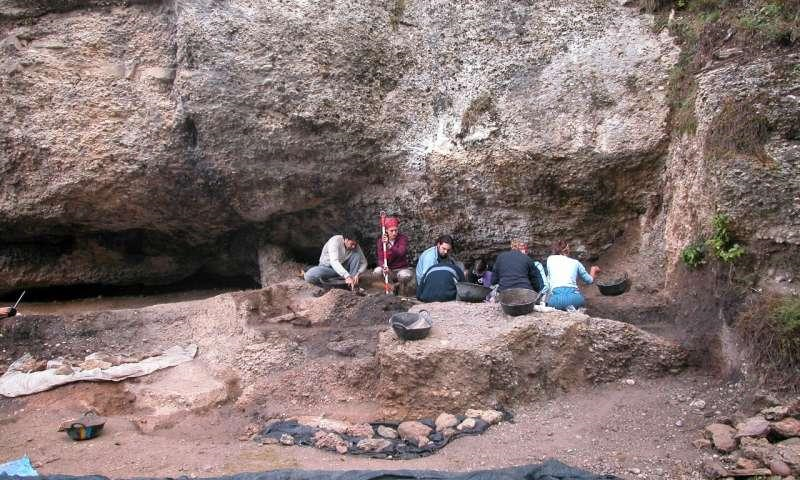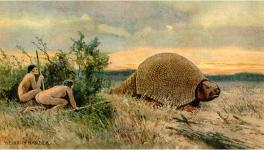Ancient DNA Analyses Reveal New Facts About Human Migration and Survival Around Ice Age

Excavation site at Iberia. Image courtesy: phys.org. Image for representational use only.
beria, the Southwest European peninsula, has long been considered as an outlier in the population history of Europe. The unique position and climate of Iberia made it an interesting topic of research. Moreover, Iberia is also interesting from the perspective of human survival and migration during the ice age. During the last ice age, Iberia became the refuge to animal, plants and human beings. This is because, during that period Iberia remained relatively warm and human beings were forced to retreat from much of the rest of Europe to live there. Over the last 8,000 years, similarly, Iberia has been a unique place due to its geographic location, rugged terrain, its position on the Mediterranean coast and its proximity to North Africa. The Iberian Peninsula is now home to Spain and Portugal.
Now, two new studies, published in Science and Current Biology have brought out unprecedented clarity about the unique population history of the region. The concurrently published studies analysed a total of 300 individuals that lived in the Iberian Peninsula from about 13,000 to 400 years ago.
Ancient Iberian Hunter- Gatherers had Two Paleolithic Lineages
The study published in Current Biology was carried out by scientists of Max Planck Institute for the Science of Human History, Jena, Germany. The team analysed 11 hunter gatherers and Neolithic individuals of Iberia. The oldest individuals in the study were recovered from Balma Guilanya in Spain and are 12,000 years old approximately.
As per the earlier evidences, hunter gatherers having ancestry of individual from Villabruna, Italy, used to dominate western and central Europe after the end of the last ice age—some 14,000 years back. Like Iberia, Italy has also been thought to be a potential refuge to human beings during the last ice age. The Villabruna related ancestry eventually replaced the earlier ancestry in western and central Europe. This earlier ancestry of central and Western Europe was related to 190,000-15,000 year old individuals that were associated with the Magdalenian cultural complex.
Now the new findings reveal that both the lineages were present in the Iberian individuals that date back to 19,000 years. “We can confirm the survival of an additional Paleolithic lineage that dates back to the Late Ice Age in Iberia,” says Wolfgang Haak, a senior author of the study. “This confirms the role of the Iberian Peninsula as a refuge during the Last Glacial Maximum, not only for fauna and flora but also for human populations.”
This suggests that the hunter gatherers of Iberia had the ancestry both from the Vallabruna and Magdalenian related sources. This discovery also suggests that there existed a connection between two refugia that resulted in a genetic ancestry which could survive in later Iberian hunter gatherers.
According to Vanessa Vilalba-Mouco, the first author of the study—“The hunter-gatherers from the Iberian Peninsula carry a mix of two older types of genetic ancestry: one that dates back to the Last Glacial Maximum and was once maximized in individuals attributed to Magdalenian culture and another one that is found everywhere in western and central Europe and had replaced the Magdalenian lineage during the Early Holocene everywhere except the Iberian Peninsula.
Analysis of Ancient DNA of Individuals Spanning 8000 Years
The Science paper analysed ancient DNA from a huge numbers of individuals and also took into account the population history of about 8,000 years. The study led by Harvard Medical School and Broad Institute analysed the DNA s of 271 individuals that belonged to Iberia through different periods—Mesolithic, Neollithic, Copper Age, Bronze Age, Iron Age. The large number of paleo DNA allowed the team to make more detailed conclusions about each time period.
The study found that as Iberia witnessed the transition towards a sedentary farming life-style, the hunter gatherers of Iberia could contribute only subtly to the genetic make-up of the farmers that were newly arriving from the East.
The researchers found that around 2500-2000 BC, 40% of Iberia’s genetic ancestry and almost 100% of its Y chromosome was replaced by people having their ancestral linkage to the Pontic Steppe, which is today’s Ukraine and Russia. Interesting enough, the study suggests that the “Steppe ancestry” did not only spread to the Indo-European speaking regions of Iberia, but also to the regions that were inhabited by non-Indo-European speaking people like the Basques. The analysis suggests that the Basque people of modern time most closely resemble an Iberian Iron Age population including the Steppe ancestry. But, they were untouched by the subsequent genetic contributions that affected the rest of Iberia. This indicates that the Basques were equally affected as other groups by the arrival of the Steppe populations, but they retained their language, and it was only after that time the Basques became genetically isolated from the rest of the Iberian Peninsula. The Basque community is one of the few groups in Europe that have retained their own non-Indo-European language.
The study also looked for historical periods when other settlements like that of Greek and Romans existed in Iberia. They found that during early Roman period, the ancestry of the peninsula was also transformed by gene flow from North Africa and Eastern Mediterranean. At some point 500 years ago, far more North African ancestry lived in Spain than today. Actually, the Muslim Africans were pushed south by the Christian Kingdom and eventually they were expelled. The DNA analysis suggests that the North African Muslims didn’t penetrate the remote Basque country.
Get the latest reports & analysis with people's perspective on Protests, movements & deep analytical videos, discussions of the current affairs in your Telegram app. Subscribe to NewsClick's Telegram channel & get Real-Time updates on stories, as they get published on our website.
















